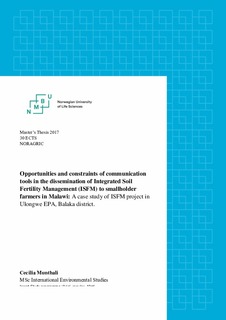| dc.description.abstract | Agricultural productivity is low in Malawi because of poor soil fertility, climate change effects and lack of agricultural inputs. Integrated Soil Fertility Management (ISFM) project has been implemented to improve soil fertility through intercropping maize with legumes. ISFM improves crop productivity and food security. However, adoption of ISFM practices has been low due to farmers lack of information and awareness of the potential of ISFM. Agricultural information is transferred to farmers through appropriate communication channels. The study investigated the impact of communication tools in the dissemination of ISFM. The research analysed the role of diverse sources of information and the effectiveness of the communication channels in the dissemination of ISFM. The study also examined farmers’ perceptions of the communication tools used by the ISFM project. The study took place in Ulongwe Extension Planning Area (EPA), Balaka district. Data was collected using household surveys, key informant interviews and focus group discussions. Data were analysed with descriptive statistics and coding. A total of 89 farmers were interviewed, 54 ISFM project members and 35 non-members.
The findings of the study showed that use of diverse sources of information in ISFM project promoted farmers implementation of the ISFM practice. Trusted sources of information encouraged farmers to disseminate and adopt ISFM. The communication channels used were extension officers, lead farmers, radios, videos, learning centres, mobile phones and print media. Farmers identified the public and ISFM extension officers and lead farmers as the most effective communication tools. Farmers preferred interpersonal communication tools because of the possibility of getting feedback, which allowed farmers and extension officers to exchange ideas and develop appropriate approaches that suit individual farmer’s needs. Radios, learning centres, videos and mobile phones were used as complementary communication tools to the extension and lead farmer. However, the study showed that print media such as leaflets were least preferred by farmers due to high illiteracy levels. From the results, the use of diverse sources of information, communication tools and frequent training of farmers were most effective for the diffusion of ISFM in Balaka. The study found a number of limiting factors of the communication tools, which included high illiteracy levels, lack of motivation and lack of electricity. Therefore, the government should promote collaboration of the ISFM project and other organisations in the area to harmonise the practices for better implementation and adoption of ISFM packages. | nb_NO |

